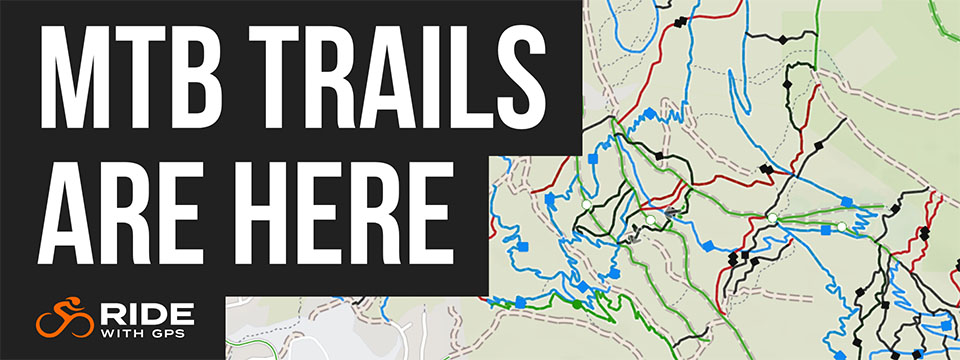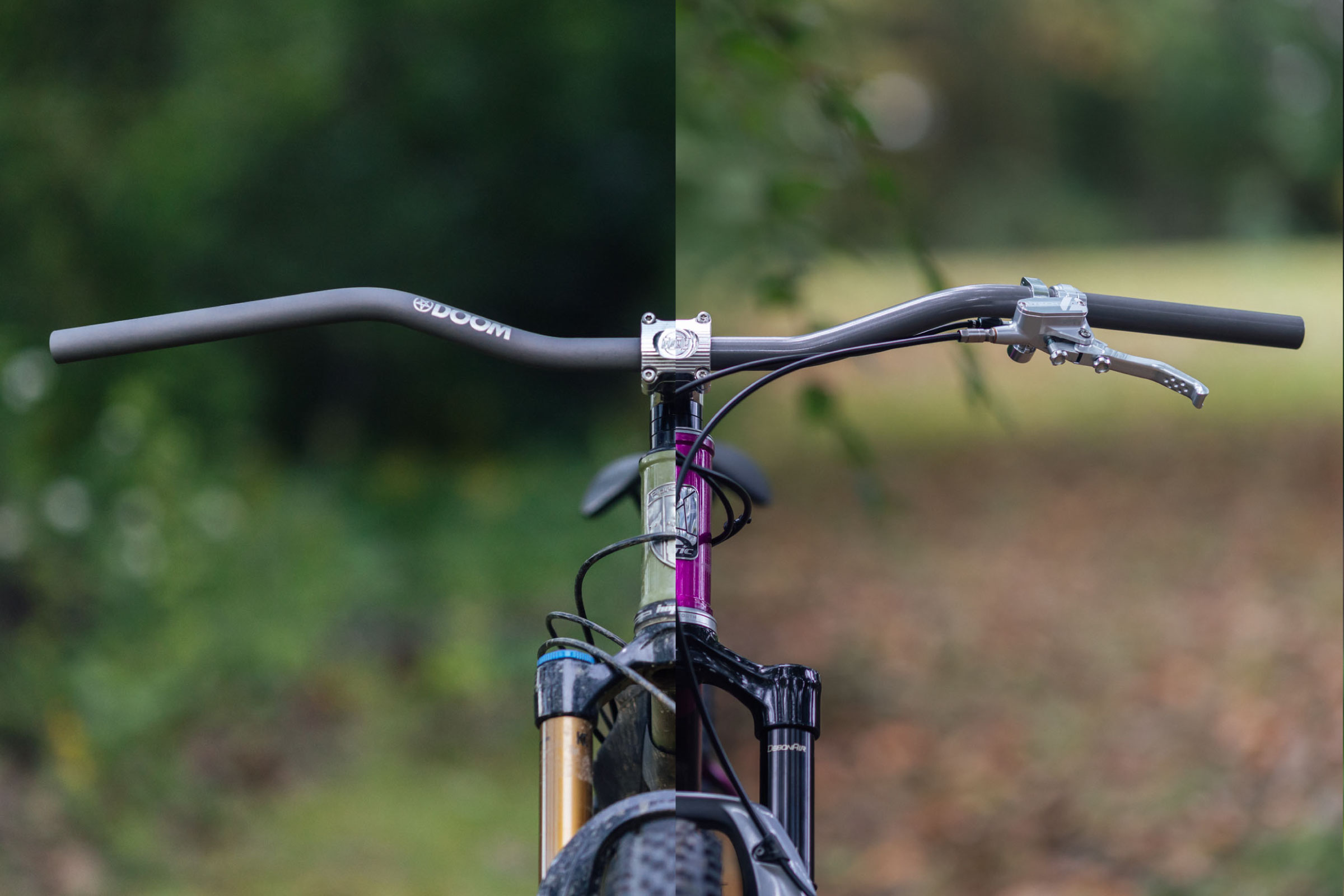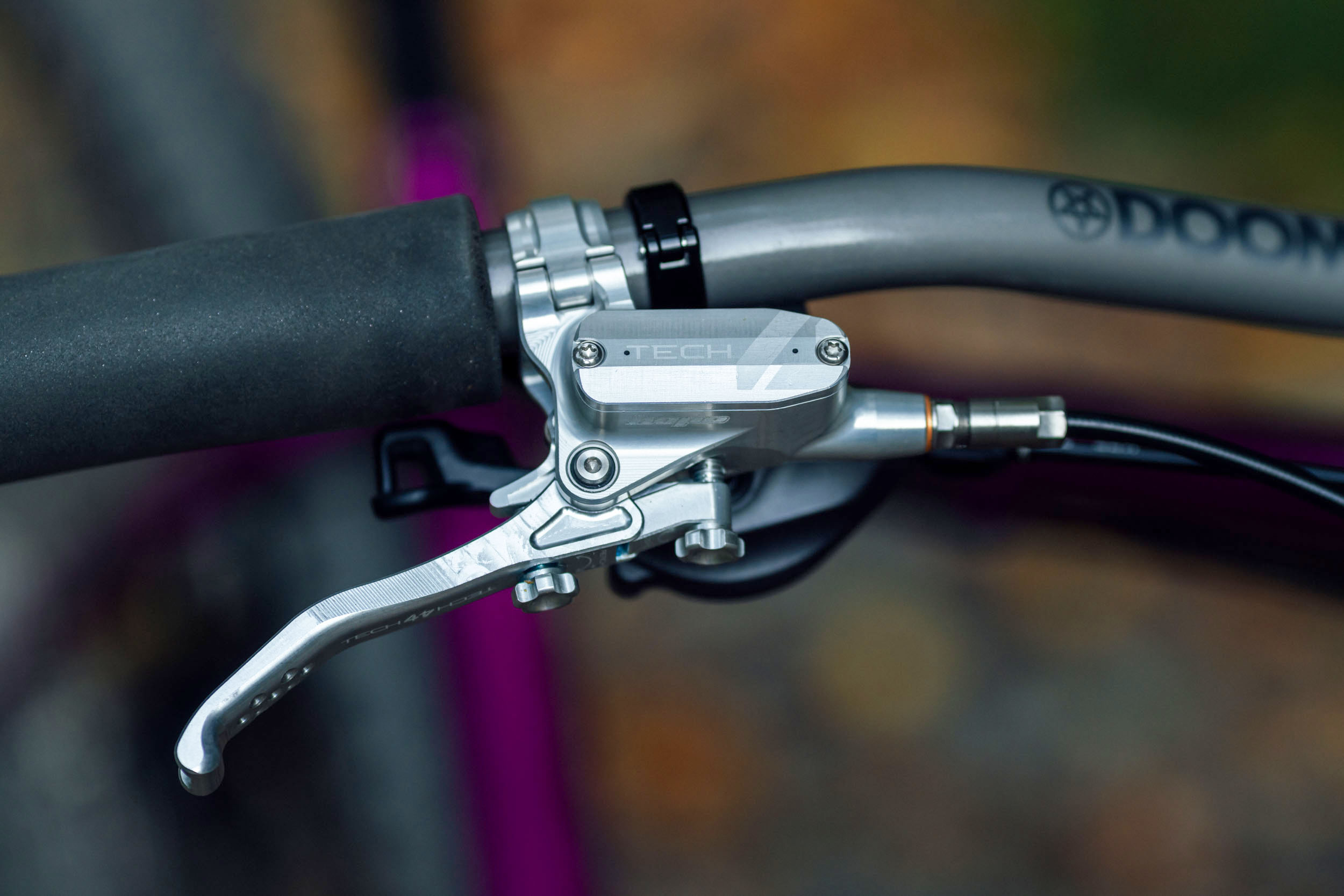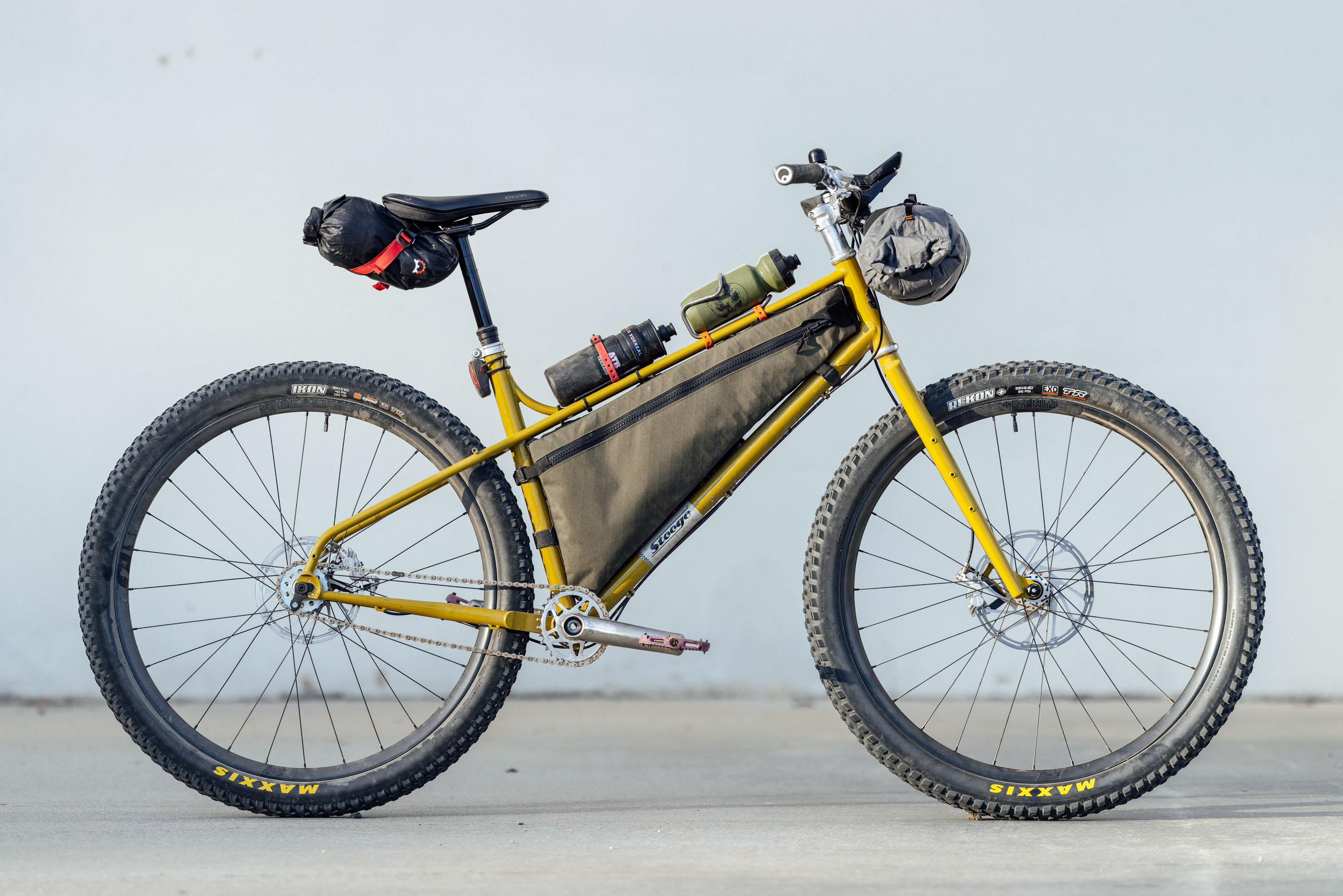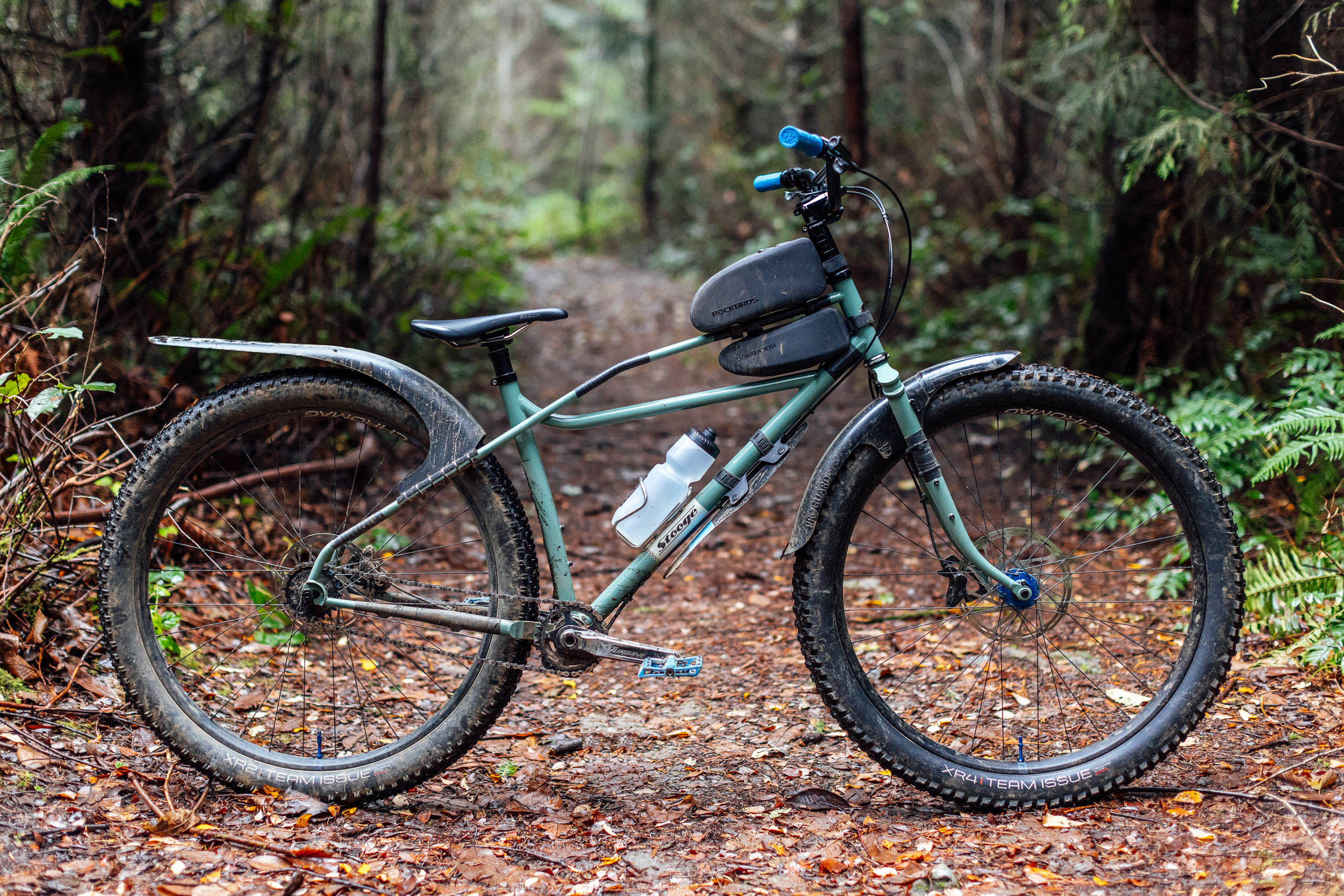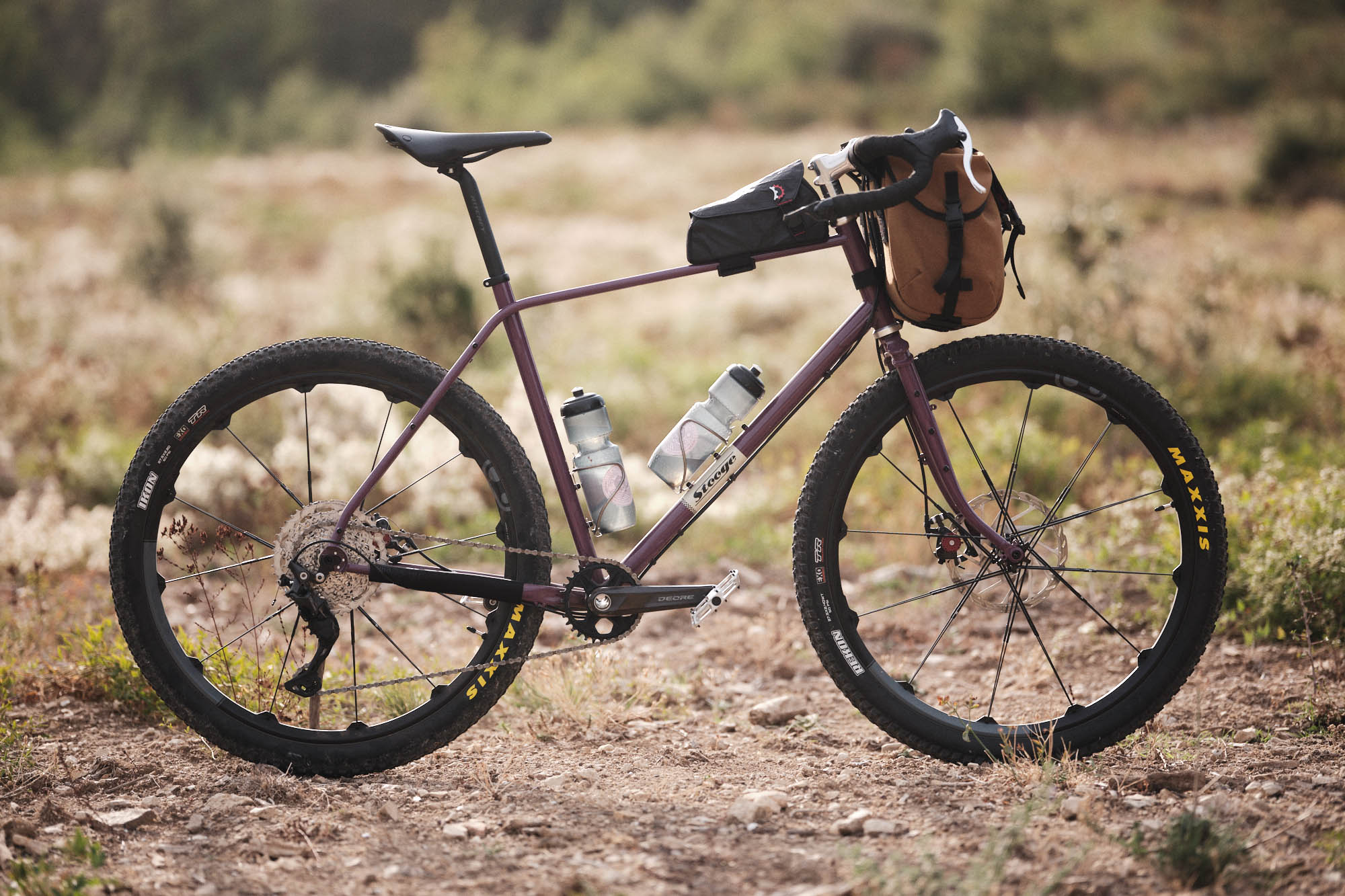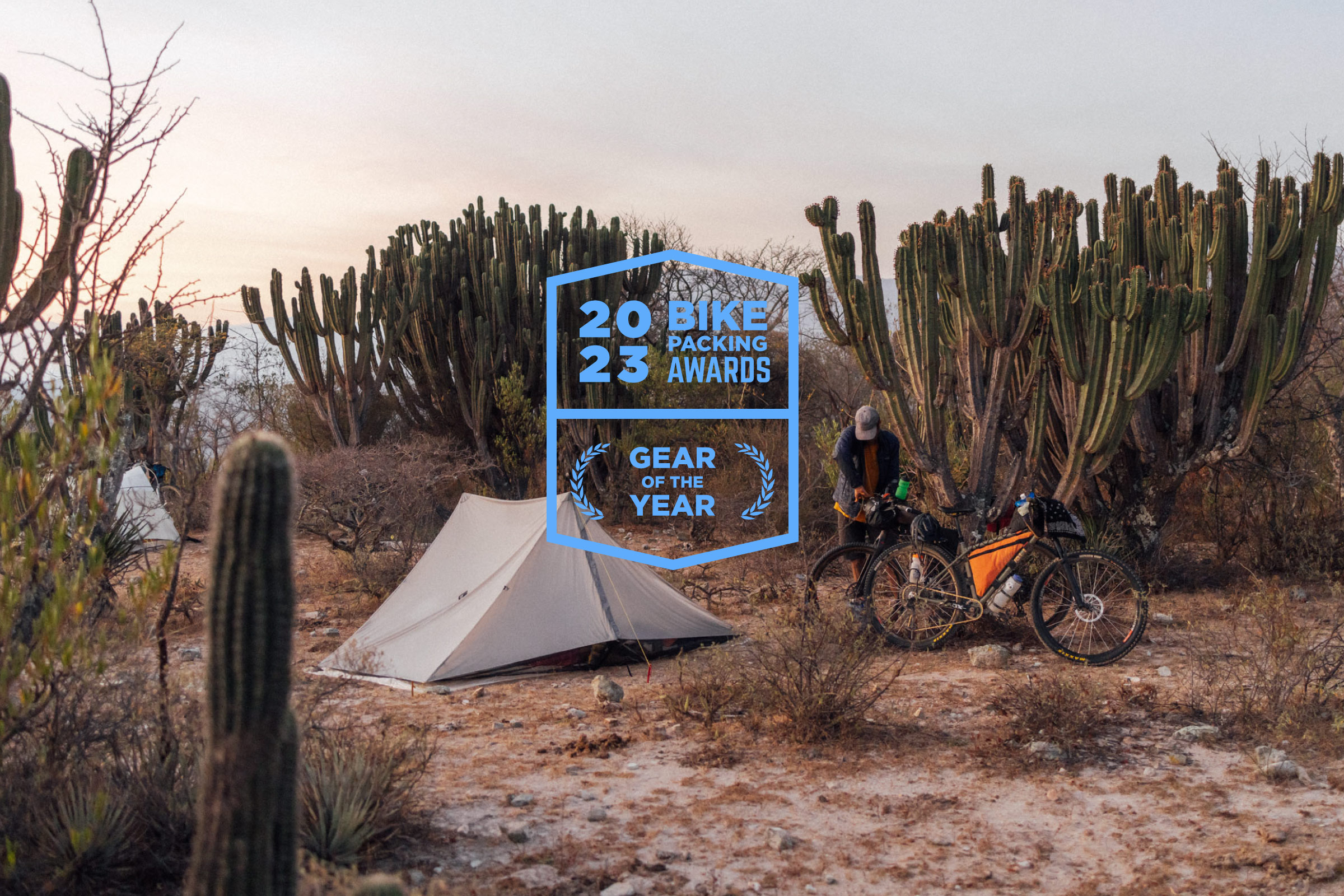Stooge Dirt Tracker Review: Convergent Evolution
The Stooge Dirt Tracker is a modern 29+ tribute to British tracker bikes from the 1950s, ‘60s, and ‘70s, which arguably could have been the first mountain bikes. We had the chance to dig into the history that inspired the 21st-century version of the Dirt Tracker and spend some time with this beauty while trail riding and bikepacking for a full review. Dive in here…
PUBLISHED May 14, 2024
With additional riding photos by TJ Kearns
On the surface, you might think the Stooge Dirt Tracker—the latest model in the UK brand’s lineup—is just another cruiser-clunker throwback. However, the roots beneath this head turner run deep. I honestly wasn’t sure what to expect when it was announced in January, especially considering how smitten I was with the MK6, but I knew I wanted to try it. With clearance for bigger tires, more mounts, and some attention-grabbing geometry differences, it looked promising. Here’s my review after a couple of months spent ripping around corners, hucking off rooty ledges, and singlespeed bikepacking through my local woods.
Dirt Trackers: The Original ATB?
At least from my side of the pond, the prevailing narrative credits mountain bikes’ origin to the American klunkers of the 1970s. In that history, the lead-up to mountain bikes was piloted by a group of free-spirited teenagers in Northern California who modified heavy steel vintage Schwinn cruisers that they bombed down dirt road descents in the surrounding hills of Marin County. However, there’s a compelling argument from many Brits that another type of bicycle merits recognition: the dirt trackers. These grassroots bikes were popular among British teenagers in the 1950s, ’60s, and ’70s, often overlooked by cycling historians who focused on the rise of mountain bikes in the US during the ’70s and ’80s.
Imagine this scene, circa 1950, in the post-war UK, where groups of teenagers cleared the rubble off of bomb sites in urban areas and built their own playgrounds, transforming these WWII ruins into makeshift dirt tracks for bicycle races. Dubbed “skid kids,” these young lads repurposed discarded work bikes and modified them by all means available. It was post-war Britain, and money was scarce, but style and durability were critical. They retrofitted them with cow-horn-shaped bars bent from old gas pipes and reinforced the forks with homemade trusses made from steel bar stock. These bikes were aptly known as “trackers” or “dirt trackers.”
This caught on across the UK and resulted in competing clubs such as the Warwick Lions, Tottenham Kangaroos, and Beckton Aces1. They sported matching self-made uniforms as they raced each other on rugged tracks amid the remnants of the UK’s war-torn cities. Similar to the clunker scenes in Marin and Crested Butte in the 1970s, this was a spontaneous cycling subculture born from the inventive spirit of youth and led by kids instead of corporations.
Throughout the 1960s and ’70s, the popularity of dirt trackers lived on. They were cobbled together from second-hand bikes, and kids modified them to look like the motocross “scramblers” of the day. They outfitted them with the largest, knobbiest tires they could find, bent their own swept-back bars, and made modifications to withstand the abuse of being hotdogged through the woods. They rode them into the dusty corners of parks and took them on adventures beyond the edges of their towns—as we did the BMX bikes of our youth here in the United States.
Trackers continued until the early 1980s when BMX came along and took the cycling scene by storm. The final specimen in the tracker bike’s long lineage was the Raleigh Bomber, which was released around the start of the decade. A few years later, BMX and mountain bikes took over off-pavement cycling, and trackers were completely forgotten in the rush toward what was new and shiny.
With a glimpse into this history, it’s easy to question exactly which bikes were the predecessors of modern ATBs and MTBs. I’m not one to say who should get credit, but as with convergent evolution in biology, similar things can evolve in multiple places simultaneously. And while the conception of the post-war UK dirt trackers doesn’t have the exact trajectory of the klunkers of Marin County, they indeed share the same sense of camaraderie, creativity, and boundless resourcefulness of youth.
When Stooge Cycles owner Andy Stevenson announced the Stooge Dirt Tracker at the beginning of the year, it was the first I’d heard of this breed of bicycle. As Andy so eloquently described in a blog post, the tracker was the style of bike that inspired an entire generation in the 1950s and 60s, his dad included. Andy’s father passed away in 2022, and it conjured memories of old sepia-tinted photos of his dad’s dirt tracker (above-right in the collage). Andy has his finger on the pulse of UK bike history, with model names like Scrambler and Rambler.
Stooge Dirt Tracker Frameset
The Stooge Dirt Tracker is a modern take on these forgotten bikes. Andy decided to approach it as if British trackers had continued to evolve and ultimately morph into “mountain crushing, trail slaying, utilitarian ultra beasts.” In summary, it’s a 29+ rigid-specific mountain bike that he claims is nearly as capable as the MK6 in the Stooge lineup and as bikepacking-friendly as the Scrambler.
The Dirt Tracker frame is impressive in person. Aside from the beautiful bi-plane fork, the most striking feature is the “crimped” top tube. It’s the same bend used on the Dirtbomb, the predecessor to the twin-top-tube-equipped Speedbomb currently in Stooge’s lineup, which has the same aesthetic bend but without the mid-triangle crossbar. Historically, the crimped top tube actually came well before the trackers of the 50s. It was a common feature on old work bikes before the Second World War, but it became prominent in the 1950s with the massive boom in the post-war tracker culture. Andy recalls his dad telling him that many kids would cut their top tube off at the seat tube, bend it, “and then bodge it back together again, just to get the style of a proper speedway bike.”
Like the Dirtbomb and Speedbomb, the Stooge Dirt Tracker is only available in a single 18-inch size. It’s made mostly from double-butted 4130 Chromoly steel and has a 30.9mm seatpost, internal dropper routing, Boost 148/110mm hub spacing, IS brake mounts front and rear, and a 73mm threaded bottom bracket with a standard eccentric bottom bracket (EBB) insert for chain-tensioning duties or slight adjustment to the BB height.
When it comes to tubing choice, there’s very little difference between the Stooge MK6 that I reviewed, the Dirt Tracker, and the Speed/Dirtbomb frames, aside from the fact that the MK6 and Speedbomb both use a twin-top-tube design. They all share similar tubing in the rear, a forged half-yoke, and the same triple-butted downtubes. The MK6 uses a slightly heavier gauge top tube to meet its capability requirements as an “all-mountain” rigid mountain bike. The Speedbomb and Dirt Tracker also get a smaller 30.9mm seat tube, as opposed to the larger 31.6 on the MK6.
Build Kit
To honor the Dirt Tracker’s storied history, I decided to build it up as a singlespeed. In hindsight, I wish I’d have taken that a step further and cobbled it together with all old and cheap parts to fully pay tribute to its lineage, but I ended up using a few new bits and several parts-bin components for this particular build.
- Frame Stooge Dirt Tracker, 18″, Duster Blue
- Fork Stooge Dirt Tracker, 65mm Offset
- Wheels Ibis, 36mm Internal Width Carbon Rims, I9 Torch Hubs
- Front Tire Maxxis Minion DHF, 29 x 3.0″
- Rear Tire Maxxis Rekon+, 29 x 2.8″
- Crankset Hope Evo, Silver, 170mm
- Chainring Hope, 30-tooth, Silver
- Cog Endless Kick Ass Cog, 21-tooth
- Bottom Bracket Hope, threaded 73mm
- Handlebar Stooge x Doom Tracker Bar, 830mm
- Stem PAUL Boxcar, 22.2 x 50mm
- Grips WTB CZ Control
- Headset Wolf Tooth
- Brakes Hope Tech4 E4, 180/200mm rotors
- Saddle Bike Yoke Sagma
- Seatpost OneUp V3, 30.9 x 210mm
- Seatpost Clamp Surly Stainless
One of the old parts I used was a relatively worn-out Endless 21-tooth cog. I partially de-anodized it using oven cleaner by spraying it and sticking it in a repurposed plastic mailer for about a minute. After hosing it off, it came out with a sweet silver/purple tie-dye-esque pattern that I was pretty happy with. I also flipped it to eke a little more life out of this beauty.
Other prized parts in this build include the 3.0 Minion DHF, one of my favorite tires of all time. It’s hard to beat this monster for carving turns and barreling over slick roots. I typically run it at about 9 to 11 PSI, which offers excellent damping, and its stiff sidewall still holds up to fast corners and quick turns on a 36mm internal width rim. It has next-level traction, and it isn’t nearly as slow as you’d expect. The silver Hope EVO crankset is another nice addition. It’s a UK-machined gem that seemed fitting for the bike and looks and performs flawlessly.
Stooge x Doom Tracker Bar
The bars that Stooge sent with this bike were an across-the-pond collaboration with Doom Bars from Albuquerque, New Mexico, and they’re truly something special. They were designed specifically for the Dirt Tracker, although they will undoubtedly be a joy on similar-minded bicycles. The Tracker Bar comes in at 880mm wide with a 70mm rise and 20° of backsweep and is made from nickel-plated 4130 Chromoly steel. I cut them down to about 830mm for my fit preference.
Stooge says they’re “very limited,” which makes sense since they’re already sold out. I’m usually a little skeptical about chromoly bars, but as expected—based on my previous experience with the Doom Bikepacker’s Delight—they offer some vibration damping, have just enough give, and sport all the right angles to be comfortable while spinning the pedals, standing and mashing, or charging downhill. Similar to the Bikepacker’s Delight, they’re a bar I feel like I could ride with all day every day for a few months, yet they also feel in control when plowing down rough and technical lines.
To the Trails
My first eye-opening ride on the Dirt Tracker was on the new Searcy Creek to Butter Gap Trail loop here in Pisgah. It’s comprised of two recently revamped trails that combine to be a flowy mix of punchy climbs and whoop-filled fast and curvy descents, with some tight turns and a couple of rocky obstacles here and there to keep you on your toes. I was blown away by how the Dirt Tracker handled that type of ride. It had all the good qualities I waxed on about with the MK6 and a dash of its own secret spices, including a a very comfortable frameset that’s compliant in all the right ways.
I already wrote 4,000 words in the MK6 review about the merits, nuance, and slightly mad-hatter engineering behind the Stooge DNA and how it has radically filled the gaps in rigid-specific mountain bike geometry. If you haven’t read that (find it linked in the Further Reading grid below), I’d recommend doing so to help make sense of the remainder of this review. Following that, to break down what makes the Dirt Tracker tick, I think the best direction is a side-by-side comparison to the MK6.
Geometry: Stooge Dirt Tracker vs. MK6
Out of the gate on the Searcy to Butter Loop, the Stooge Dirt Tracker clicked. It felt wildly playful, and I was surprised at how stable and sure-footed it seemed. With a 19mm longer wheelbase and 15mm lower bottom bracket than the MK6, the added stability and confidence make sense.
Both the MK6 and Dirt Tracker have a 66-degree head tube angle, and they also share a similar effective seat tube angle and stack height, although the Dirt Tracker’s reach is slightly longer. As a result, the Dirt Tracker feels a little bigger from a fit perspective, and it also just seems larger in general due to the higher top tube and longer stance.
| Model | Dirt Tracker | MK6 19″ | Speedbomb |
|---|---|---|---|
| Effective top tube | 625 | 625 | 625 |
| Seat tube length | 457 | 483 | 457 |
| Head tube length | 140 | 157 | 140 |
| Chainstay length | 450 | 445 | 450 |
| BB drop (+/-7mm) | 75 | 60 | 75 |
| Fork a/c | 455 | 455 | 455 |
| Fork offset | 65 | 57 | 57 |
| Head angle | 66 | 66 | 66 |
| Seat angle (actual) | 73 | 74 | 73 |
| Seat angle (virtual) | 74.5 | NA | 74.5 |
| Reach | 459.6 | 451.4 | 459.6 |
| Stack | 604.5 | 605 | 604.5 |
| Seatpost diameter (clamp) | 30.9 (33) | 31.6 (34.9) | 30.9 (33) |
Broadly speaking, I found that the Dirt Tracker inspired more of a chin-over-stem body position than the MK6, which oddly has a more old-school mountain bike feel. The MK6 seemed to encourage me to move further back over the rear wheel when railing down more rugged trails, allowing the front tire to skip over rocks and roots. I’d been riding the Pipedream Moxie leading up to my time with the Dirt Tracker, which requires a forward stance to weight the fork. That made me wonder if doing so on the Dirt Tracker was just out of habit, but after riding both the MK6 and DT back to back, my theory was confirmed.
Aside from the DT’s longer wheelbase, the Dirt Tracker fork is the X-factor. Not only does its massive 65mm offset place the wheel further out front, but the fork also has a more plush feel than the MK6’s heavy-duty segmented fork. That could be a catch-22 for riders anticipating bigger hits and drops. Watch some of Jeff Kendall-Weed’s videos from the past six months, and you’ll see why. After jumping his Dirtbomb off some big red rock ledges in Sedona, he ultimately bent the bi-plane fork and had to replace it with the straight/segmented model used on the MK6 to suit his riding style.
I certainly don’t ride like Jeff Kendall-Weed and don’t see myself attempting massive road gaps with the Dirt Tracker, so this is a non-issue for me. I decidedly prefer the feel of the Dirt Tracker fork over that of the MK6, but I admittedly had a little nervous voice in the back of my head about the compounded beating it might take from bad line choices and extra-hard landings. That being said, Andy told me that this is a very different biplane fork from the earlier ones that “Jeff so gleefully trashed.” That one had thinner biplane blades, and that’s where the damage would happen rather than the fork legs. To solve this, the newer biplane fork use much thicker steel for the blades which are also spread further apart, making them structurally stronger.
A-B Testing
To properly compare these two bikes, my friend Nic and I took the MK6 and Dirt Tracker out for an A-B testing ride. Both were set up with the same singlespeed gearing and had a 3.0″ Minion DHF in the front inflated to 9.5 PSI. They also each had a Maxxis Rekon in the back inflated to about 16 PSI, although the MK6 had a 2.6″ version due to clearance limitations and the Dirt Tracker was shod with a 2.8. As for build kits, the MK6 was about a pound lighter because of a more svelte wheelset, the smaller rear tire, and aluminum bars.
We rode the same loop twice and switched bikes a couple of times along the way to get a feel for each while climbing, descending, and pedaling on the flats. It was surprising how two remarkably similar bikes can feel shockingly different when you switch mid-ride.
We found a few interesting takeaways on this ride. Nic quickly reported that the Dirt Tracker has more of an in-the-bike feel than the MK6. We also agreed that the MK6 felt a little faster and more spritely than the Dirt Tracker. This might be attributed to its lighter build and slightly smaller rear tire, but I think there’s a little more to it than that. The larger seat tube and heavier-gauge twin top tube help make it a stiffer and more responsive frame. In contrast, the Dirt Tracker’s thin top tube and smaller seat tube give it a moderately more toned-down and supple frame feel. It isn’t slow, by any means, but riding the two side by side, there’s a notable difference. A 2.6″ tire and lighter build would probably minimize the discrepancies. That being said, the Dirt Tracker’s wider true 29+ tire clearance is a welcome addition.
One thing we didn’t see completely eye-to-eye about was the steering. Nic thought the MK6 steering felt all-around quicker and lighter. I thought the MK6’s steering seemed oddly quicker on the flats but that the Dirt Tracker’s steering felt lighter and faster while descending. Theoretically, the 8mm longer offset on the Dirt Tracker should make it quicker on both accounts, but perhaps the longer wheelbase and chainstay length help negate that. Either way, they both offer that Stooge rigid MTB magic, where the relatively slack head tube angle and long fork offset work in unison to maintain confidence and allow for quick line changes to stay nimble and dodge rocks and trail debris.
Andy has experimented with fork offsets extensively over the years and admits to being fascinated by how offset alone can tune and manipulate a bike’s feel. When I asked Andy about his rationale behind the longer offset on the Dirt Tracker, he mentioned that he wanted it to carry a front load and still have light steering and said, “Unloaded, I wanted the handling to be quick and playful, at odds with the longer chainstays.”
For me, the 66-degree head tube angle and massive 65mm offset paired with the perfectly low 75mm bottom bracket drop gave the Dirt Tracker incredible cornering ability. It’s fast in and out of corners, yet it maintains its line without the wheel being sucked underfoot when things get squirrely. Those same attributes also give it a brazen level of confidence when confronting steps, ledges, and technical descents. For this reason, having the front tire way out in front is a pretty amazing quality on a rigid mountain bike.
So, is the Dirt Tracker better than the MK6? That’s a tough ask. Both Nic and I agreed that if we could only have one of them, it would probably be the Dirt Tracker. For my part, that speaks volumes since my closing statement in the MK6 review was that, if pressed, it might be the one bike I’d be happy to spend the rest of my life with. Nic’s hot take is that the MK6 doesn’t feel all that far off from other bikes he has in his stable, but the Dirt Tracker feels quite unlike anything else.
While Out Bikepacking
The Dirt Tracker has a few obvious advantages over the MK6 for bikepacking and dirt touring. For one, it has a larger frame triangle to accommodate a bigger frame bag, like this lovely custom bolt-on/lace-up model made by Rockgeist. It has quite a few more mounts, too, including the mid-blade seat stay eyelets I used with a prototype MICA rear rack shown here and two additional pairs of bottle bosses: one under the downtube and a set on the seat tube. The fork is also fully equipped. It has full-width mid-blade mounts to allow the use of threaded eyelets on the blade’s interior or with a full-width bolt for something like the Rod Steward bag support. It has both upper and lower front rack mounts as well.
The Dirt Tracker also felt great once packed up. I haven’t outfitted it with a super-bulky oversized load, but it seemed stable and generally stiff enough to handle a minimal or medium-weight bikepacking kit.
- Model/Size Tested: Stooge Dirt Tracker, 18″
- Actual Weight (frame+fork): 4.5 kilograms (9.9 pounds)
- Place of Manufacture: Taiwan
- Price: £720
- Manufacturer’s Details: Stooge Cycles
Pros
- Incredible ride quality and supple feel that’s still lively and quick
- Lower BB with a slightly longer chainstay and more fork offset offers a brilliant blend of stability and playfulness
- The perfect Stooge aesthetic with beautiful curves and bends
- All the mounts you could need
- Bi-plane, raked-out fork is a thing of beauty
- Doom Tracker bars are the icing on the cake
Cons
- Not available in multiple sizes
- I’d still love to see this bike with a sliding dropout vs. the eccentric BB
- A third mount on the downtube would be useful for larger cargo cages
- Not many left in stock at the time of writing!
Wrap Up
At this point, you might be wondering who the Stooge Dirt Tracker is for, or if you’re seriously ogling Stooge’s lineup, whether you should pull the trigger on one or wait for the next batch of MK6s, Speedbombs, or Scramblers. That latter part of the question is one I can’t answer because, based on my experience, they’re each special in their own right. Somehow, the Dirt Tracker is a more unconventional bike than the MK6, although they’re both unlike anything else available on the market. It’s certainly more versatile, with more gear-carrying options and clearance for true 29+ tires. And it’s also incredibly comfortable. Nic and I agreed that it’s a bike that we could pedal all day for weeks on end. To paint it with a broad brush, I’d define the Dirt Tracker as the quintessential dirt-touring trail cruiser, a bike you can load up and happily pedal off into the sunset with zero complaints. Unloaded, it still delivers endless grins while chasing friends on trails, whipping through berms, popping over whoops, and carving turns until your heart’s content.
To Andy, the Dirt Tracker was about unlocking memories and applying his insightful geometry to bring a historical bike into the present. “For me, it’s very special, and yet for most people, it might just be another bike,” he mentioned. There’s nothing that ties me to the history of this bike, but I still find Dirt Tracker to be far more than just another bike.
I’ve jumped around a bit on this review, so if you have any questions about particular comparisons or qualities, please ask away in the conversation below.
1 From “Cycle speedway: The ‘skid kids’ who raced bicycles on WW2 bomb sites” by the BBC (link).
Further Reading
Make sure to dig into these related articles for more info...
Please keep the conversation civil, constructive, and inclusive, or your comment will be removed.









